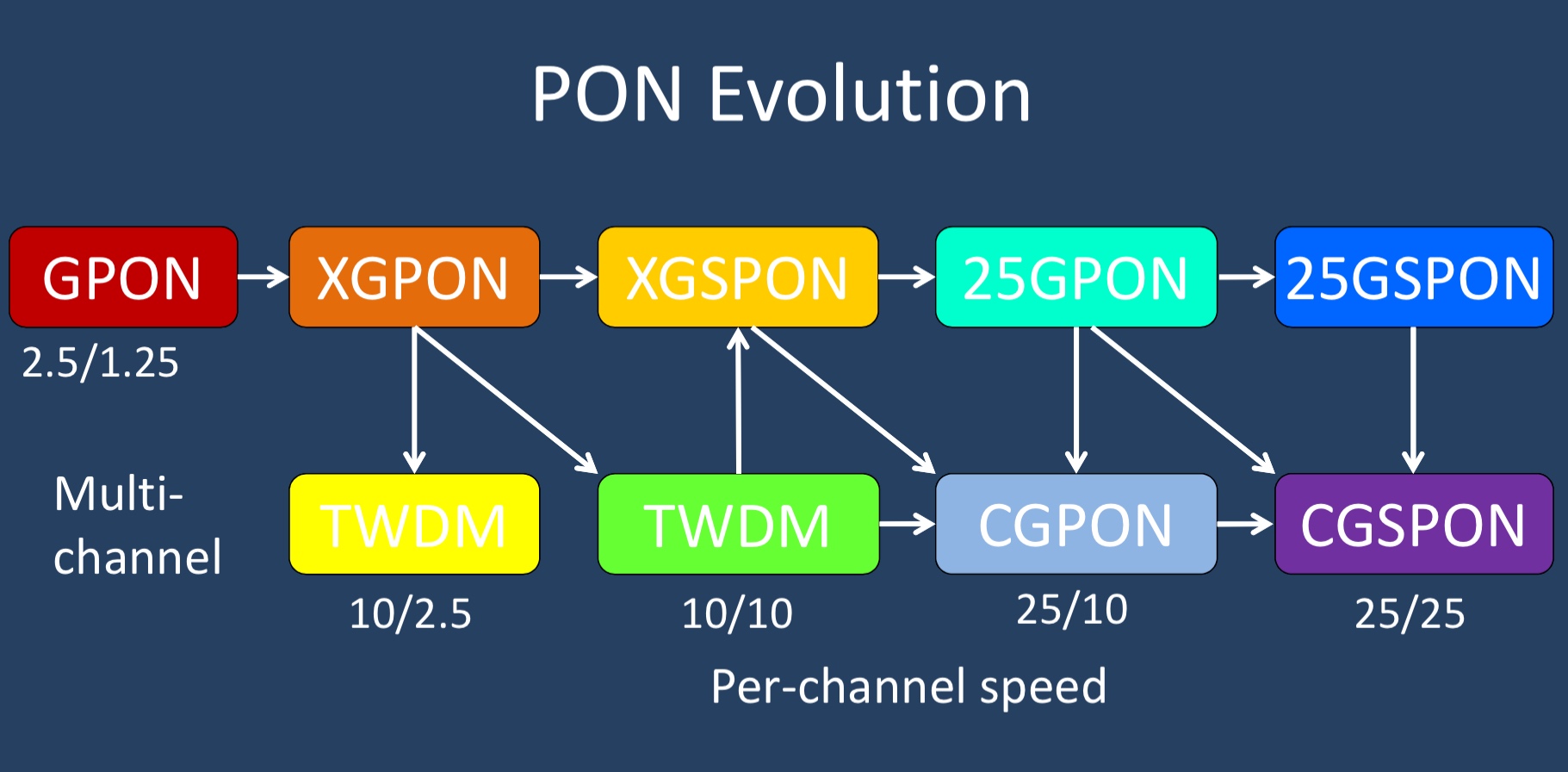100 gigabit the next stop on PON's roadmap
 Thursday, March 10, 2016 at 9:25AM
Thursday, March 10, 2016 at 9:25AM A Q&A with Frank Effenberger, vice president of the Fixed Access Network Laboratory at Futurewei Technologies, the US subsidiary of Huawei. Effenberger is also rapporteur of the ITU-T Q2/15 group that standardises optical access.
 Source: Huawei
Source: Huawei
Q. What are the various ways the industry is considering implementing 100 Gigabit?
FE: The work happening now is to do a 25 gigabit-per-second wavelength, and then multiple wavelengths will be combined in some way to create 50-gigabit or 100-gigabit speed offerings.
Q. The IEEE 802.3ca is developing 100 gigabit EPON whereas the ITU-T/FSAN has defined NG-PON2. What does the development of 100 gigabit EPON mean for the future of NG-PON2?
The ITU NG-PON2 was a future PON project that was started in 2011 with the goal of reaching at least 40 Gigabit per PON system. This was achieved in 2015 when the whole series of standards was completed. During this time, the highest economical speed was 10 gigabit.
Now that time has passed, 25 gigabit-per-lambda is becoming more reasonable, and so the ITU plans to study 25 gigabit in both the multi-channel setting - that is NG-PON2, and in a single-channel setting that would be a follow-on to the XGS-PON system. These PON systems should not be seen as a single-point development but part of an evolution.
The IEEE 802.3ca work is complementary to this work, and many of the same people go to both standards groups - certainly Huawei does. It is in everybody’s interest to reuse components and technologies, and I’m confident that this will happen for the 25-gigabit generation just as it has in previous PON generations.
Q. In a press release, Huawei mentioned it is demonstrating a 100-Gigabit PON prototype. What is Huawei demonstrating and how has it been implemented?
The 100 gigabit PON prototype is an early look at the 25 gigabit-per-wavelength technology. Given that the standardisation is only beginning, we had to make many assumptions, but such prototypes give us a chance to find any issues early.
The details of the prototype will be more fully explained at the OFC conference, but in brief, what we have is a system that implements 25 gigabit downstream and 10 gigabit upstream per wavelength pair. A real PON MAC is operating in this system, and full PON operations: activation, ranging, dynamic bandwidth allocation etc. are taking place. The 25-gigabit transmission is done using either conventional non-return-to-zero (NRZ) or optical duobinary line coding.
Q. How is 100 gigabit PON envisaged to work with existing systems?
100 gigabit PON will co-exist with previous PON generations, most likely using a WDM-style of interworking. This is the same method used to allow G-PON, XG-PON, and TWDM-PON to co-exist on a single-fibre network.
Q. What in Huawei’s opinion are the main challenges to be overcome regarding 100 gigabit PON?
 Frank EffenbergerThere are two technical challenges to this system.
Frank EffenbergerThere are two technical challenges to this system.
First, 25 gigabit-per-wavelength transmission over 20km of standard fibre that meets the approximate 30dB loss budget and the aggressive cost targets of access is difficult. This will take time to solve.
Second, combining multiple PON channels into a single virtual channel is not trivial because it requires some level of coordination between the channels. There are solutions, but they need more study to confirm their operation.
Q. What will the advent of Nx25 gigabit do to reduce the cost of PON?
That is a loaded question, because you presuppose that 25 gigabit will lower the cost. To first order, our hope is to keep the cost-per-endpoint increase to a reasonable level. Obviously, the cost-per-bit will decline significantly, but the access business is not so tied to this factor. The key factor in higher-speed PON is to increase the system and user speed while trying to hold costs steady.
The industrial readiness of TWDM-PON is not really at a mass deployment stage; furthermore, the 'killer app' that just absolutely demands TWDM’s capacity is not immediately at hand
Q. Besides showing operators an extended roadmap beyond 40 gigabit, what applications will require 100 gigabit PON?
In reality, while 100 gigabit PON makes for a nice headline, the story is more complex. There are two separate applications where we see the technology.
The first is a single-channel 25-gigabit system that would be useful for residential applications. This would serve as a follow-on to the XG-PON or 10GEPON deployments, and it could be at a price point that allows that.
The second is the full 100 gigabit PON with four channels. This would be useful for business services, for mobile backhaul and fronthaul, and fibre-deep architectures like G.fast (fibre-to-the-distribution point) and DOCSIS3.1 (D-CMTS).
Q. Huawei has also detailed a 10 and 40 gigabit NG-PON. Is this a combination of time- and wavelength-division multiplexing that in effect supports a traditional time-division multiplexed PON per wavelength i.e. TWDM-PON with rates that include 10 gigabit symmetrical, 10 gigabit downstream and 2.5 gigabit upstream, and 2.5 gigabit symmetrical?
You describe it correctly. The NG-PON2 system’s major solution is the TWDM-PON, which defines 4- or 8-wavelength pairs that can be used simultaneously, with 10 gigabit- or 2.5 gigabit-per-wavelength. So, it can reach a total capacity of 80 gigabit per PON.
In addition, NG-PON2 also defines a WDM overlay component, which supports eight or more channels of 10 gigabit per wavelength (not TDMed). All in all, the system capacity could reach over 160 gigabit.
Q. Is this system commercially deployed?
So far, there have been only small trial deployments. Huawei has deployed its early TWDM systems in many operators' networks in Europe and in Asia, but we are not at liberty to disclose these collaborations other than what has been announced. The industrial readiness of TWDM-PON is not really at a mass deployment stage; furthermore, the 'killer app' that just absolutely demands TWDM’s capacity is not immediately at hand.
When will it be deployed is a hard question.
Keep in mind that 10 gigabit PONs were standardised and prototyped by 2010, and yet it is 2016 and we still don’t see huge deployment; the first small-scale movements are starting to happen in China. That’s a six-year lag!
If NG-PON2 is true to that, then it predicts 2021 as the start of significant deployment. Barring the introduction of some super bandwidth-hungry service, I think it will still be some time before we deploy any next-generation system.
Q. What will be the first applications for 10G-40G NG-PON systems?
The envisioned applications for TWDM-PON was primarily residential and small business, with the simple assumption that bandwidth increase will continue to grow to 1 gigabit-per-second. A 40-gigabit PON, serving 32 customers typically, fits this Gigabit FTTH picture well. But that seems far away for now. Early deployments will likely be business services and wireless backhaul.



Reader Comments